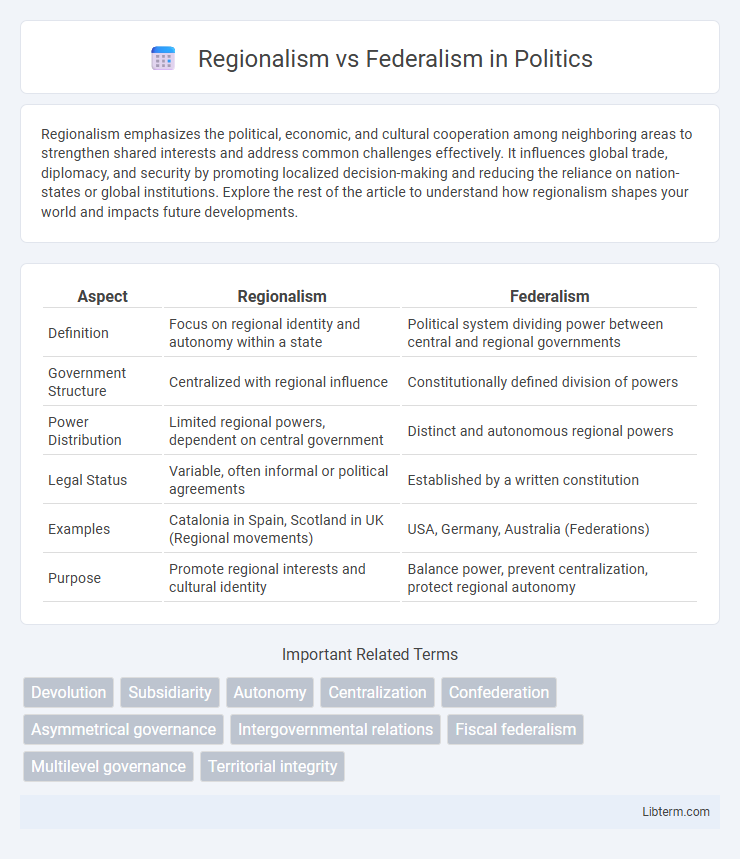Regionalism emphasizes the political, economic, and cultural cooperation among neighboring areas to strengthen shared interests and address common challenges effectively. It influences global trade, diplomacy, and security by promoting localized decision-making and reducing the reliance on nation-states or global institutions. Explore the rest of the article to understand how regionalism shapes your world and impacts future developments.
Table of Comparison
| Aspect | Regionalism | Federalism |
|---|---|---|
| Definition | Focus on regional identity and autonomy within a state | Political system dividing power between central and regional governments |
| Government Structure | Centralized with regional influence | Constitutionally defined division of powers |
| Power Distribution | Limited regional powers, dependent on central government | Distinct and autonomous regional powers |
| Legal Status | Variable, often informal or political agreements | Established by a written constitution |
| Examples | Catalonia in Spain, Scotland in UK (Regional movements) | USA, Germany, Australia (Federations) |
| Purpose | Promote regional interests and cultural identity | Balance power, prevent centralization, protect regional autonomy |
Understanding Regionalism: Definition and Key Features
Regionalism emphasizes the political, economic, and cultural autonomy of specific regions within a country, often driven by distinct historical, ethnic, or linguistic identities. Key features include the promotion of local governance, preservation of regional languages and traditions, and advocacy for decentralized decision-making to address localized needs effectively. This approach contrasts with federalism's structured power-sharing system, as regionalism highlights the unique interests and identities of particular areas rather than a constitutionally mandated division of authority.
Federalism Explained: Structure and Principles
Federalism is a political system where power is constitutionally divided between a central government and subnational entities, such as states or provinces, allowing each to exercise certain exclusive powers. This structure balances unity and diversity by enabling regional governments to legislate on local matters while the federal government handles national issues like defense, currency, and foreign policy. Core principles of federalism include autonomy, shared rule, and constitutional supremacy, ensuring cooperation and conflict resolution mechanisms between levels of government.
Historical Evolution of Regionalism and Federalism
Regionalism and federalism have evolved as distinct political frameworks responding to diverse historical contexts of decentralization and governance. Regionalism often emerged from cultural, linguistic, or economic identities seeking greater autonomy within a state, notably in 19th-century Europe and post-colonial nations. Federalism developed as a constitutional arrangement dividing sovereignty between central and regional governments, exemplified by the United States in 1787 and Switzerland's longstanding cantonal system.
Political Motivations Behind Regionalism
Political motivations behind regionalism often stem from a desire to address local identities, cultural distinctions, and economic priorities that centralized federal systems may overlook. Regionalism advocates push for greater autonomy to influence policy decisions, control resources, and preserve unique regional characteristics within or alongside federal structures. Such movements frequently emerge in response to perceived political marginalization or inefficiencies in federal governance, highlighting the tension between centralized authority and regional self-determination.
Federalism as a Framework for National Unity
Federalism serves as an effective framework for national unity by distributing power between central and regional governments, allowing diverse communities to coexist under a single sovereign state. This system balances regional autonomy with national coherence, reducing conflicts arising from ethnic, cultural, or linguistic differences. By providing constitutional mechanisms for shared governance, federalism fosters political stability and inclusive representation across varied populations.
Advantages and Disadvantages of Regionalism
Regionalism promotes local governance and cultural preservation, enhancing political representation and tailored policy-making based on regional needs. However, it may lead to fragmentation, uneven development, and conflicts between regions and central authorities. Economic disparities can widen as regions with fewer resources struggle to compete or receive adequate federal support.
Strengths and Weaknesses of Federalism
Federalism allows for a balanced distribution of power between central and regional governments, promoting local autonomy and tailored policy-making that addresses diverse regional needs effectively. It enhances political participation and accountability by creating multiple levels of government closer to the citizens, fostering innovation through policy experimentation. However, federalism can lead to inefficiencies and conflicts due to overlapping jurisdictions, inconsistent policies, and potential competition among regions, sometimes complicating national unity and coordinated policy implementation.
Economic Impacts: Regionalism vs Federalism
Regionalism often fosters localized economic development by tailoring policies to specific regional needs, enhancing resource allocation and infrastructure investment within distinct areas. Federalism promotes economic integration and uniformity by balancing power between national and regional governments, facilitating broader market coordination and interstate commerce. Both frameworks significantly influence economic stability, investment flows, and fiscal decentralization, impacting growth and regional disparities.
Case Studies: Regionalism and Federalism Around the World
Case studies of regionalism and federalism reveal diverse governance models shaped by historical, cultural, and political contexts, such as Canada's bilingual federalism balancing Quebec's regional identity and Germany's federal system emphasizing strong Lander autonomy. India exemplifies federalism managing ethnic and linguistic diversity with state autonomy, while Spain's regionalism showcases devolution struggles in Catalonia and the Basque Country seeking greater self-governance. These examples highlight how federalism and regionalism address demands for local representation, resource control, and identity preservation within sovereign states.
Future Prospects: Choosing Between Regionalism and Federalism
Future prospects of governance involve evaluating Regionalism and Federalism based on political stability, economic growth, and cultural identity preservation. Regionalism emphasizes localized autonomy and cultural specificity, potentially fostering regional development and tailored policies, while Federalism offers a balanced power distribution between central and regional governments, enhancing national unity and legal consistency. The choice hinges on a country's historical context, demographic diversity, and governance goals, aiming to optimize administrative efficiency and social cohesion.
Regionalism Infographic

 libterm.com
libterm.com